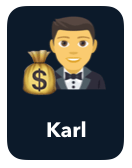
Once you’re starting to have a clear picture of the pain points, the value businesses look for, and you’re able to confirm that a few organizations are willing to spend money to solve the problem your business solves, you’ll want to start understanding the B2B buying process in these organizations.
Selling in B2B usually means convincing a group of influencers within an organization – a jury – to buy into your solution.
For example, in the following video, Karl from the purchasing team acts as the economic buyer:
Understanding the Role of the Buying Influencers
The economic buyer — through a form of veto over purchases — acts as gatekeeper of the budget. For this reason, he/she tends to be concerned with the ROI of the solution.
Julie, not Mike her boss, acts as the Technical Buyer, the person most concerned that your solution does what you say it does.
Julie’s team members are the user buyers, the people who will be using the product from day to day. Because of that, they’re particularly interested in the user experience of your product and the specific value that it delivers.
Whether or not you’re able to quickly identify these buying influences, remember that someone always plays these roles. Maybe a single person plays all roles in a small business, but the influences are always there.
Don’t make quick assumptions. The CEO is not always the decision maker and the technical buyer is not always in IT. You need to do your research.
Just to complicate things, you’ll also need to consider Blockers or Saboteurs.
Blockers are customer stakeholders who try to prevent a deal. They may: dislike your organization as a supplier, prefer a competing supplier, or want to maintain the status quo. In our case, Karl was the blocker.
And if you’re lucky, you can get a Coach or an internal Change Agent to help you understand the internal dynamics of the organization.
This is the role Emma could play for your organization, or at least she could help you find an appropriate coach in the organization.
Based on customer interviews, you’ll want to start mapping the internal processes, budgets and influencers.
To do this, you’ll want to dive into problem ownership, decision-making and buying processes, and internal influencers.
At this point, you should be able to have more regular interactions with the stakeholders who have bought your product.
You’ll want to figure out who the four or six people making the decision are. Who also needs to get involved in decision-making?
Customer Interview Questions to Map the B2B Buying Process
You can start mapping the B2B buying process by asking questions like:
- If you identify the need for a new product in your department, how does your team typically go about purchasing the solution?
- Where does the money come from?
- Who gets involved? At what moments?
- Who else in your company shares these problems?
- Who would most benefit from solving this problem?
- Whom else in your company should we be speaking with regarding this problem?
- Who is involved with doing X?
Your goal is to find a way to repeat sales and identify ways to provide value to the entire buying team.
So, who needs to get involved? Start mapping the buying process, learn what matters, and start repeating sales.
More on the B2B Buying Process
- How to Create a Sales Influence Map And Identify the Buying Influencers
- The Role of the Technical Buyer in B2B Customer Development
- The Role of the Economic Buyer in B2B Sales & Customer Development
Download the First 4 Chapters Free
Learn the major differences between B2B and B2C customer development, how to think about business ideas, and how to assess a venture’s risk in this 70-page sampler.
Working on a B2B Startup?
Learn B2B customer development with our free email course:


